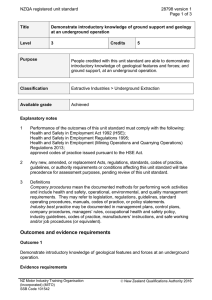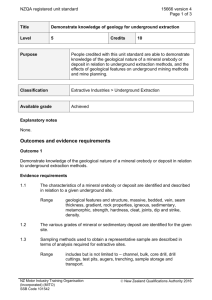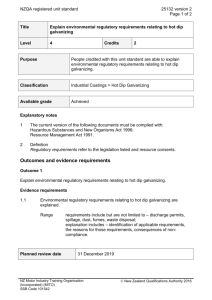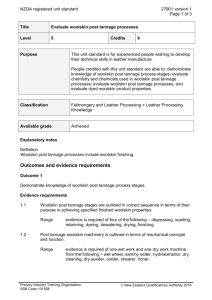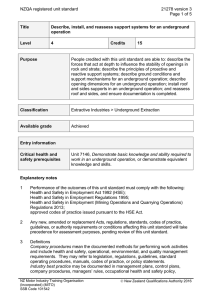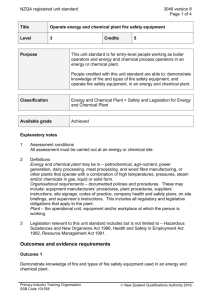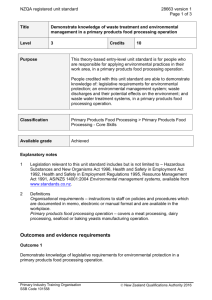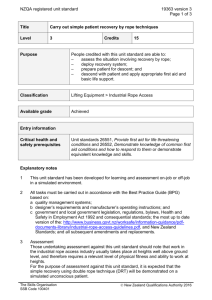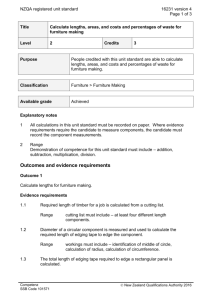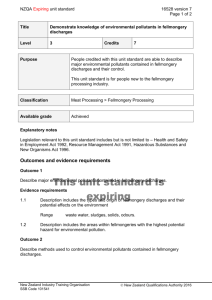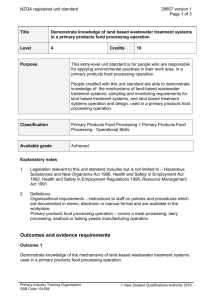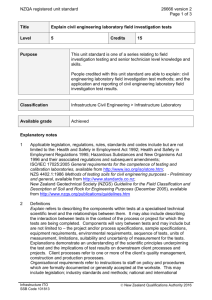22057 Demonstrate knowledge of pneumatic and hydraulic
advertisement
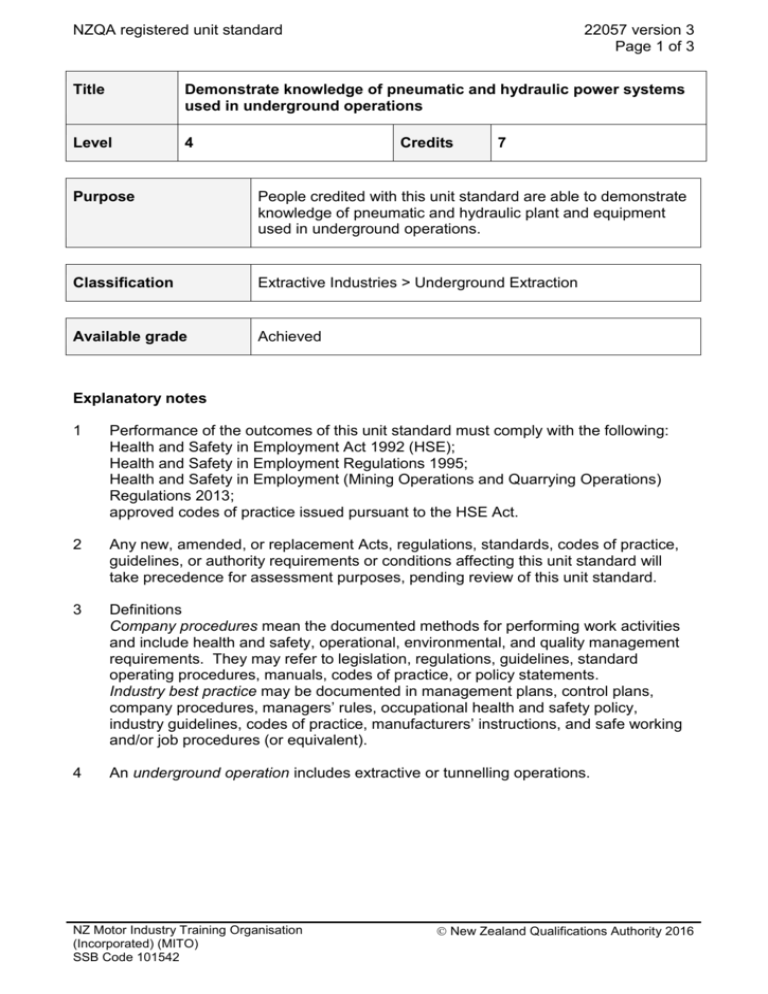
NZQA registered unit standard 22057 version 3 Page 1 of 3 Title Demonstrate knowledge of pneumatic and hydraulic power systems used in underground operations Level 4 Credits 7 Purpose People credited with this unit standard are able to demonstrate knowledge of pneumatic and hydraulic plant and equipment used in underground operations. Classification Extractive Industries > Underground Extraction Available grade Achieved Explanatory notes 1 Performance of the outcomes of this unit standard must comply with the following: Health and Safety in Employment Act 1992 (HSE); Health and Safety in Employment Regulations 1995; Health and Safety in Employment (Mining Operations and Quarrying Operations) Regulations 2013; approved codes of practice issued pursuant to the HSE Act. 2 Any new, amended, or replacement Acts, regulations, standards, codes of practice, guidelines, or authority requirements or conditions affecting this unit standard will take precedence for assessment purposes, pending review of this unit standard. 3 Definitions Company procedures mean the documented methods for performing work activities and include health and safety, operational, environmental, and quality management requirements. They may refer to legislation, regulations, guidelines, standard operating procedures, manuals, codes of practice, or policy statements. Industry best practice may be documented in management plans, control plans, company procedures, managers’ rules, occupational health and safety policy, industry guidelines, codes of practice, manufacturers’ instructions, and safe working and/or job procedures (or equivalent). 4 An underground operation includes extractive or tunnelling operations. NZ Motor Industry Training Organisation (Incorporated) (MITO) SSB Code 101542 New Zealand Qualifications Authority 2016 NZQA registered unit standard 22057 version 3 Page 2 of 3 Outcomes and evidence requirements Outcome 1 Demonstrate knowledge of pneumatic plant and equipment used in underground operations. Evidence requirements 1.1 The components and operation of pneumatic plant and equipment are described in terms of their use in underground operations. Range 1.2 Pneumatic systems are described in terms of their common faults and hazards occurring in underground operations. Range 1.3 includes but is not limited to – air power, compressors, capacity, pumps, compressor drives, motors, valves, sensors, control systems, air quality, water traps, distribution, pipes, hoses, receiver tanks, connections, gauges. includes but is not limited to – filtration, leakage, sealing, burst lines, static electricity. The safety and protection systems for pneumatic systems in underground operations are described in terms of legislation and industry best practice. Range includes but is not limited to – isolation and lock-out procedures, stored energy, safety protection systems. Outcome 2 Demonstrate knowledge of hydraulic plant and equipment used in underground operations. Evidence requirements 2.1 The components and operation of hydraulic systems are described in terms of their use in underground operations. Range 2.2 includes but is not limited to – power pack, distribution system, rams, valves, accumulators, hoses, connectors, pumps, motors, tanks, control systems, seals, filters, hydraulic fluid, cooling systems, gauges. Hydraulic systems are described in terms of their common faults and hazards occurring in underground operations. Range includes but is not limited to – filtration, leakage, sealing, burst lines, over-heating, corrosion. NZ Motor Industry Training Organisation (Incorporated) (MITO) SSB Code 101542 New Zealand Qualifications Authority 2016 NZQA registered unit standard 2.3 22057 version 3 Page 3 of 3 The safety and protection systems for hydraulic systems are described in terms of the legislation and industry best practice. includes but is not limited to – isolation and lock-out procedures, stored energy, safety protection systems. Range Replacement information Planned review date This unit standard replaced unit standard 18704. 31 December 2019 Status information and last date for assessment for superseded versions Process Version Date Last Date for Assessment Registration 1 23 September 2005 Rollover and Revision 2 16 July 2010 Review 3 18 June 2015 31 December 2017 31 December 2017 N/A Consent and Moderation Requirements (CMR) reference 0114 This CMR can be accessed at http://www.nzqa.govt.nz/framework/search/index.do. Please note Providers must be granted consent to assess against standards (accredited) by NZQA, before they can report credits from assessment against unit standards or deliver courses of study leading to that assessment. Industry Training Organisations must be granted consent to assess against standards by NZQA before they can register credits from assessment against unit standards. Providers and Industry Training Organisations, which have been granted consent and which are assessing against unit standards must engage with the moderation system that applies to those standards. Requirements for consent to assess and an outline of the moderation system that applies to this standard are outlined in the Consent and Moderation Requirements (CMR). The CMR also includes useful information about special requirements for organisations wishing to develop education and training programmes, such as minimum qualifications for tutors and assessors, and special resource requirements. Comments on this unit standard Please contact the NZ Motor Industry Training Organisation (Incorporated) (MITO) info@mito.org.nz if you wish to suggest changes to the content of this unit standard. NZ Motor Industry Training Organisation (Incorporated) (MITO) SSB Code 101542 New Zealand Qualifications Authority 2016
